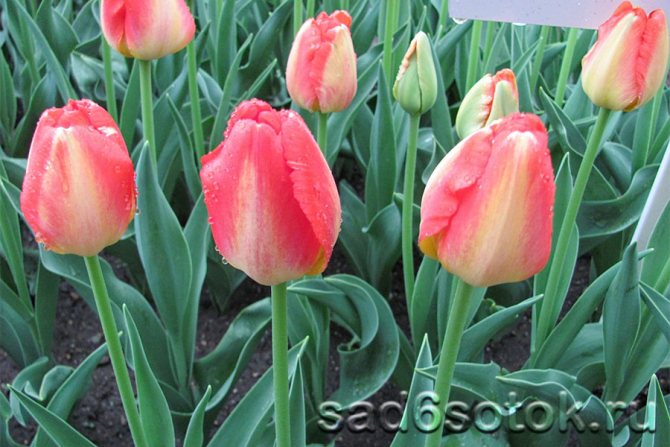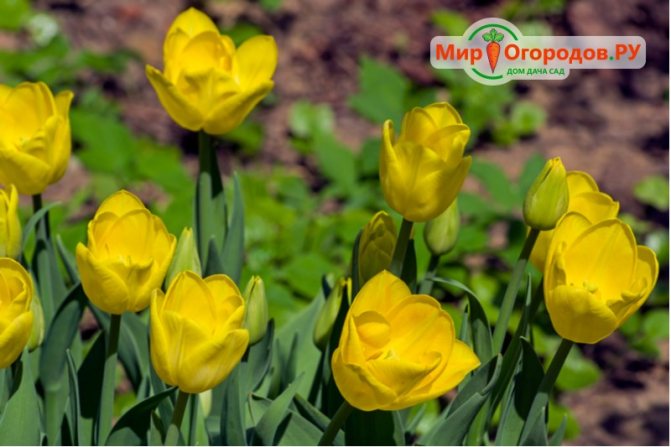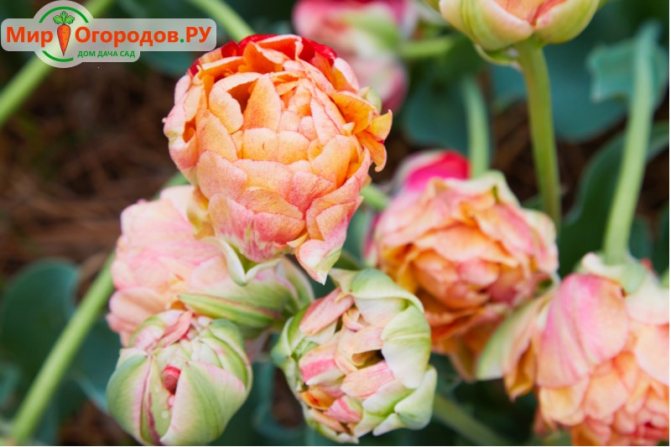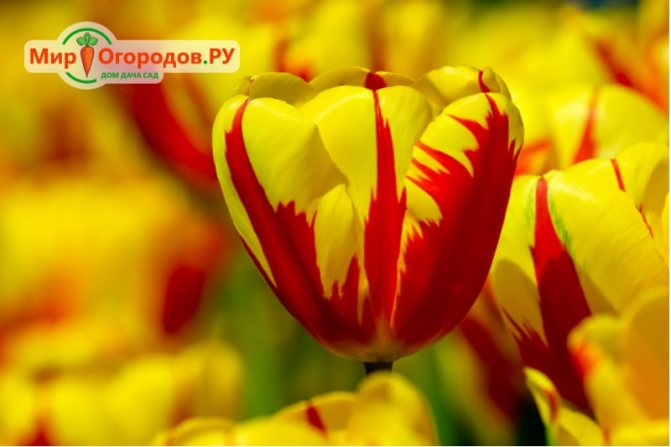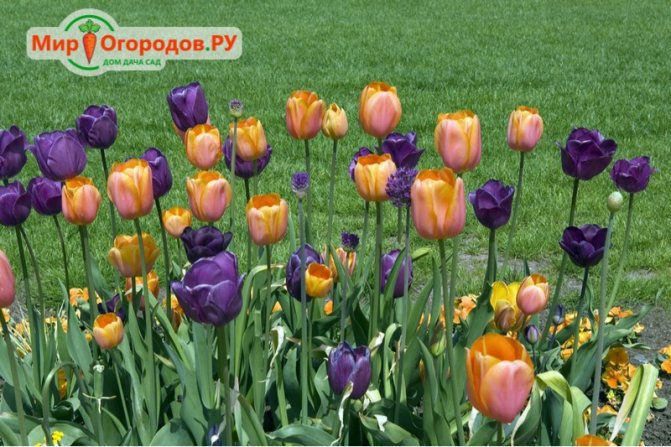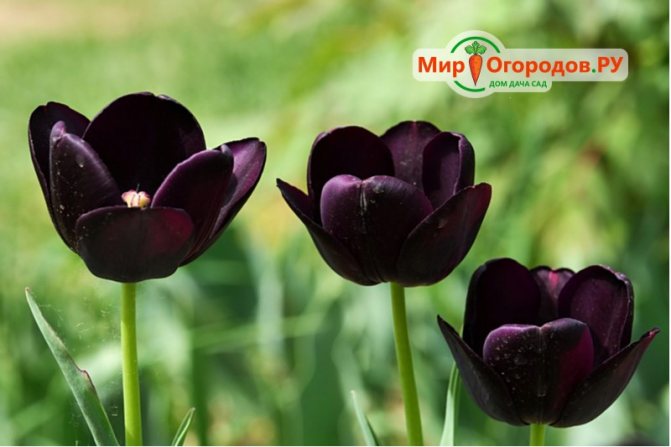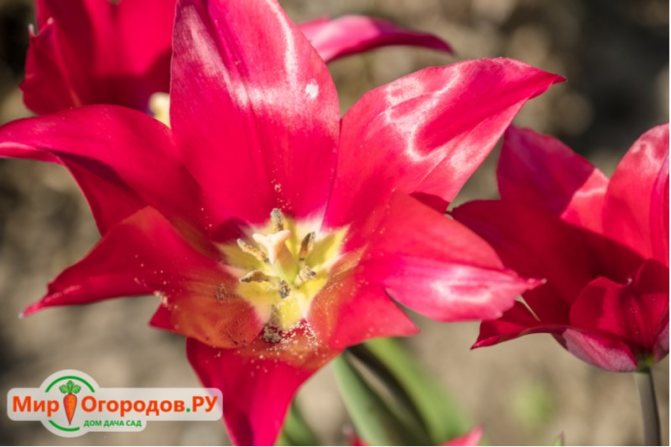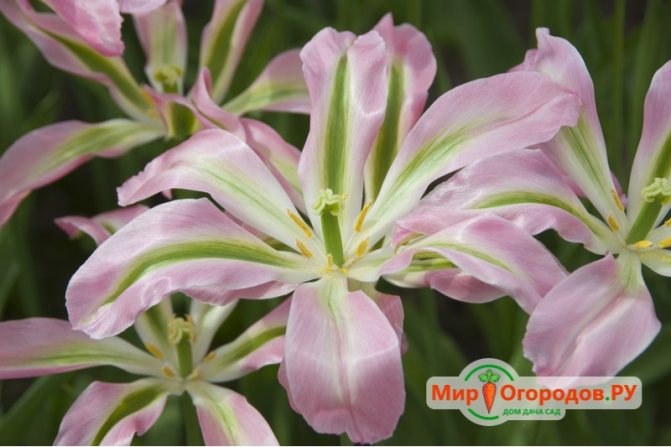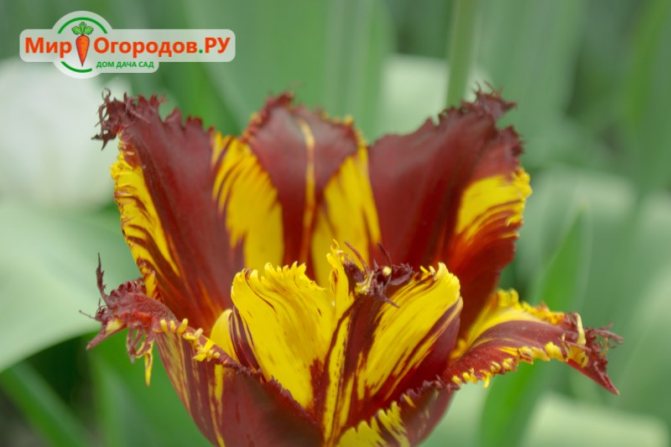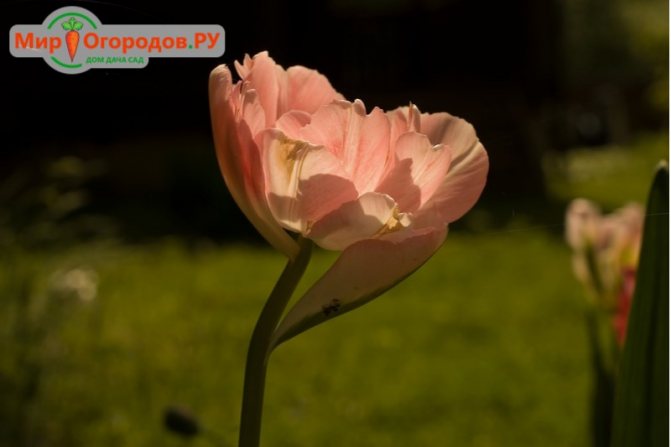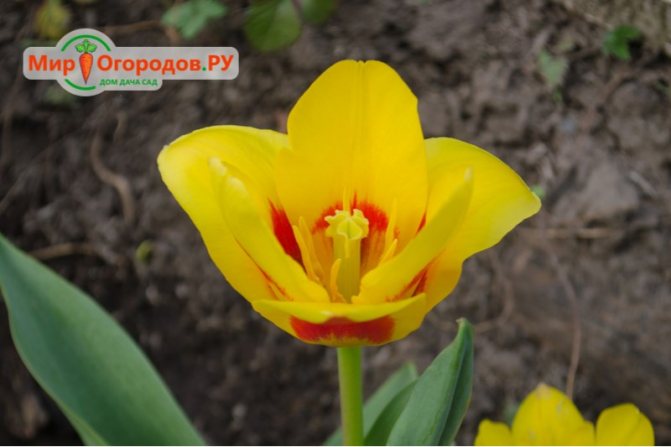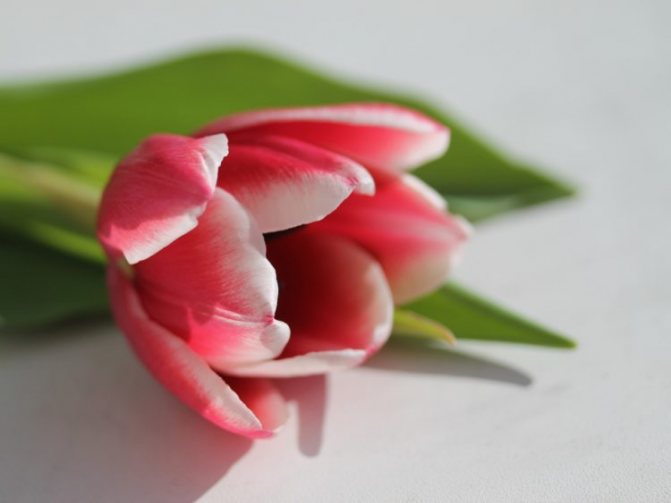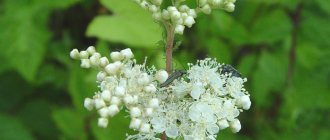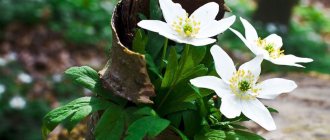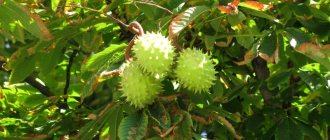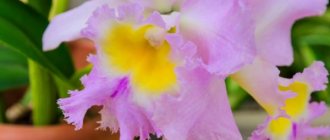Tulips are a symbol of warm sunny spring. They are grown in private gardens, in suburban areas, in small flower beds to somehow brighten up the dull cityscape, and are also bred on an industrial scale. The homeland of this plant is Central Asia, and its name translated from Persian means "turban", which the flower itself looks like. The tulip was sung by many Persian poets, even Hafiz himself mentioned this beautiful flower in his creations. The Turks also had a special love for tulips - the sultan's wives bred them to prove their love to their lord.
Tulip: description
- If we talk about tulips, then they had to go a long way. These flowers were first mentioned in Persia. It was only by the middle of the 16th century that tulips were brought to Europe, where they were quite successfully introduced. Some peoples, for example, the Dutch, even had farms and industries for the cultivation of these plants.
- Tulips are considered spring flowers, a symbol of warmth and spring.
- The tulip is a herbaceous plant that is characterized by a fairly short growing season.
- The tulip is one of the fastest growing plants. It can grow up to 2 centimeters per day. This type of flower grows in a vase of water after being cut.
- Tulip bulbs are pear-shaped or egg-shaped. On top of them there is a covering scales. In the description of the tulip bulb, a pointed top and a flattened bottom are clearly traced. The size of this part of the flower, the shape of the scales and color may differ depending on the variety.
- In a tulip, the root is located at the bottom of the bulb. At the young seedling stage, this plant has one main root, which dies out at the end of the first growing season.
- Tulip leaves have an elongated-pointed or elongated-oval shape. They clasp the stem tightly. Some varieties of tulips have ridged growths on the surface of the leaf.
- Tulip flowers consist of 3 inner and 3 outer petals. Hybrid species of this plant may have more petals. Most often, there is one bud on one plant, but there are varieties of tulips that are characterized by the development of several buds.
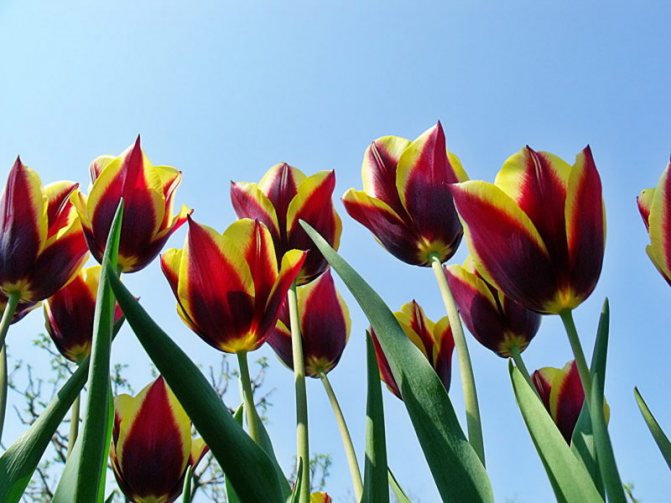
How to prepare seed
Tulips can be planted with seeds collected from the boll of the plant. But it will take 4-5 years to wait for the first flowering. As a rule, such a condition is suitable for botanists and breeders. Summer residents use only bulbs for planting.
Before planting, the bulbs must be trained:
- Selection - only healthy, whole heads with a diameter of up to 3 cm are chosen. Any ones with signs of the disease are immediately destroyed.
- Preventive treatment - often carried out in a weak solution of potassium permanganate. The seed is left for half an hour and then immediately planted.
When inspecting the bulbs for diseases, you need to carefully remove its husk, since it is under it that a focus of infection can be found.
If a spring planting is planned, the bulbs are hardened before soaking, leaving them in the refrigerator overnight.
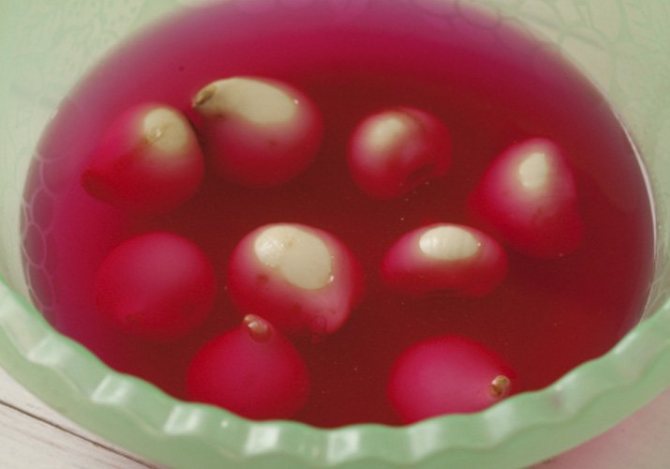

Tulip bulbs in a weak solution of potassium permanganate
Types and varieties of tulips
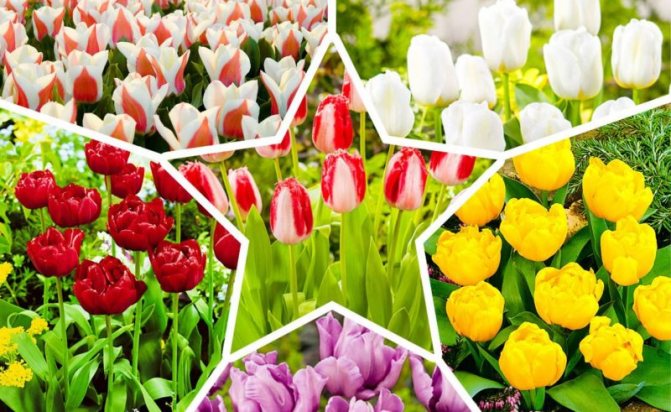

- The great tulip is a perennial bulbous plant, the height of which can reach 45 centimeters.This flower has broad leaves of a bluish-green hue and single goblet flowers. The flowering period for this tulip variety can begin at the end of April.
- The hairy-lamellar tulip is a perennial bulbous plant with a height of up to 25 centimeters and with smooth linear leaves of a light green tone. Flowers in this species are solitary and can be up to 5 centimeters in diameter. Usually these tulips are golden yellow. Their flowering begins in mid-April and ends in early May.
- The Kaufman tulip is a bulbous plant, the stem of which can be up to 20 centimeters high. This plant has wide leaves with dark veins and single flowers up to 8 centimeters in diameter. The outer surface of these flowers is yellow, and the throat is raspberry pink. The flowering of this plant begins in mid-April.
- The superb tulip is a perennial bulbous plant with a height of up to 30 centimeters. The leaves of such a tulip are wavy and bent. The flowers of this plant are wide open, and reach up to 14 centimeters in diameter. The flowering period of such a tulip begins in early May and lasts about 10 days.
- The Bieberstein tulip is a bulbous perennial flower that is characterized by slender gray-green stems, which reach a height of 30 centimeters. The bud of this type of tulip is drooping, and the flower is wide open and has a star-shaped shape. Usually these flowers are golden yellow or white. These tulips begin to bloom in April-May.
Read also: Mosses, species, structure, reproduction, meaning, interesting facts
Late blooming
Having planted plants of this group, you will be able to enjoy flowers at the end of April. The buds bloom amicably, and a wide variety of hybrids allows you to choose crops of a wide variety of shades.
Early flowering hybrids are simple and double. They are worth considering in more detail. From the video you will find out what varieties of horticultural crops are.
Simple early
It is these cultures that are considered the oldest and most popular. They have a strong, low stem that does not break from strong wind and rain. The buds are in the shape of a glass or a cup, but it is disturbed by the influence of sunlight and the inflorescence opens wider (Figure 1).
Among the popular types, Gesner (Schrenk) is distinguished, which is propagated by seeds. The petals are yellow or red, but sometimes double-colored plants are found.


Figure 1. Types of simple early flowers: Gesner (left) and Candy Prince (right)
Candy Prince is also popular - a delicate lilac flower that belongs to simple early hybrids, but is suitable for cutting due to its large peduncle and strong stem.
Terry early
Terry early hybrids are not tall, but are very popular due to their unusual shape and their bright colors. Suitable for growing both in pots and in flower beds. Peduncles are highly durable and do not break even when filled with rainwater.
Among the terry varieties are distinguished (Figure 2):
- Ice Cream - combines creamy and bright pink shades. The stem is strong, but the hybrid itself is not suitable for growing in regions with a lot of rainfall. Excess moisture leads to rapid death and degeneration of plants.
- Monte Carlo is a plant with large yellow buds (up to 10 cm in diameter when fully opened). Differs in resistance to unstable weather conditions and diseases.
- Terry red in appearance resembles a poppy, but the flowers are much larger, and can reach 12 cm in diameter.
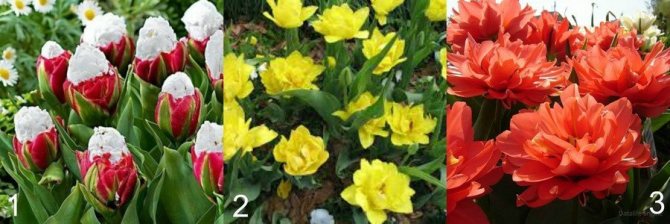

Figure 2. Types of terry early colors: 1 - Ice Cream, 2 - Monte Carlo, 3 - Terry red
The buds bloom in May, but the flowering time is short. However, with proper care, the beginning of flowering can be reduced, and the buds will appear at the end of April, and will last until mid-May.
Mid-flowering hybrids are very diverse, and are popular with summer residents due to their abundant flowering, bright shades of petals and resistance to temperature extremes.
Triumph
Triumph is a separate species that includes several varieties. The plant was obtained by selection method. A characteristic feature is a high stem and a regular goblet shape of the bud.
It is the flowers of this direction that are widely used for cutting, since they perfectly retain the shape of the bud and are stored for a long time.
Popular types of Triumph are as follows (Figure 3):
- Alexander Pushkin is distinguished by a dark lilac color with a white or pink border around the edges. Great for creating bouquets and flower beds.
- Havran is a plant with a rich dark purple hue, which can sometimes reach almost black color. The stem is tall and strong, and the crop is resistant to disease and frost.
- Denmark - bright red buds with a yellow border around the edges of the petals. The flowers are large and the stems are strong, so the hybrid is great for cutting.
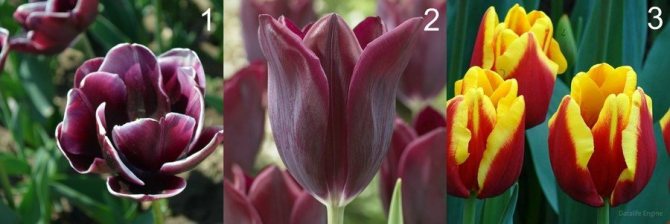

Figure 3. Plant varieties Triumph: 1 - Alexander Pushkin, 2 - Havran, 3 - Denmark
Darwin hybrids
Crops belonging to this species can reach 80 cm in height. The flower, although it has the correct goblet shape, opens up too much. However, Darwin's hybrids are prized for their resistance to frost and disease.
Despite the strong opening of flowers, this species is used both for landscaping flower beds and for cutting. Among the popular hybrids, there are (Figure 4):
- Eric Hofsue - pale pink buds without edging along the edge of the petals. The stem is high, the buds are large and well stored after cutting.
- Russian princess - pink flowers with a wide cream edging. The shape of the flower is goblet, not fully revealed. Great for bouquets due to its pleasant aroma and long-term storage.
- Marias Dream is one of the best hybrid species. The petals are milky, with a narrow golden stripe in the center. Looks good both in the flowerbed and in the flower arrangement of the bouquet.
Read more: Hydrangea serrata Bluebird winter hardiness planting and care photos and description
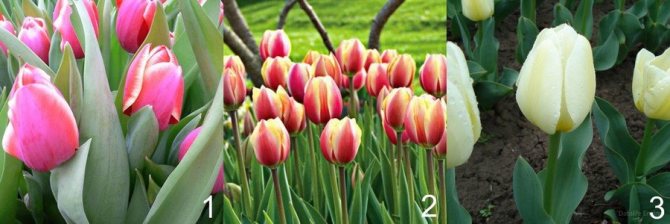

Figure 4. Varieties of the species Darwin hybrids: 1 - Eric Hofsue, 2 - Russian princess, 3 - Marias Dream
Such crops bloom at the end of May. They tolerate heat well, but can die from a sharp drop in temperature (late frosts). To protect the flowers, you need to prepare a covering material, and cover the flower bed with it if there is a threat of frost.
The group of late flowering varieties is considered the most diverse. It includes many subspecies, which will be discussed below.
Simple late
Plants with a very strong stem. The base of the flower is square, but generally looks like a glass. The petals can be of the most varied colors, but the main feature is that not one bud can form on the stem, but several at once (Figure 5).
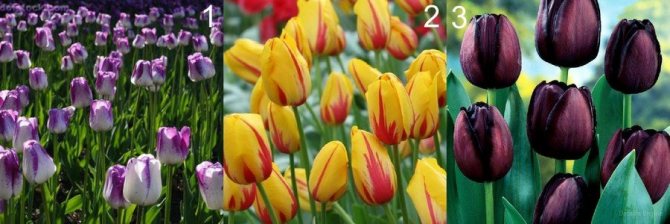

Figure 5. Varieties of simple late flowers: 1 - Shirley, 2 - Prince Vladimir, 3 - Queen of Night
Among the popular species are the Shirley hybrids with ivory petals and a lilac border, the Prince Vladimir hybrid with bright yellow petals and a red stripe in the center. But the most original is the Queen of Night hybrid - maroon, sometimes almost black, which looks very impressive in bouquets.
Terry late
Outwardly, the flowers are very similar to peonies because of the lush petals. The peduncle stem is dense, but even it cannot always withstand the entire buds in strong gusts of wind. Therefore, it is better to plant terry species in a place protected from the wind.


Figure 6. External features of double late colors
There are many varieties of double late blooms, which are distinguished by a wide variety of petal shades. For example, the Angelica variety with white-pink petals resembling an apple blossom. It looks very impressive in a flower bed, but due to the large weight of the inflorescences, it is not suitable for cutting (Figure 6).
Lily-colored
They were bred several centuries ago, but are still very popular due to the unusual shape and color of flowers.


Figure 7. Features of lily-colored species
A characteristic feature is the petals, which lengthen and bend closer to the tip (Figure 7). They are often used to decorate flower beds and bouquets, but in general they are considered quite rare in comparison with other late-flowering species.
Parrot
The most unusual varieties belong to the parrot species. The edges of their petals are uneven, so they resemble bird feathers.
The stems are quite tall, up to 65 cm, and the flowers, when fully open, can reach 20 cm in diameter. Because of this, parrot species are used mainly for decorating flower beds, since they are too fragile for bouquets.


Figure 8. Appearance of parrot species of culture
The prominent representatives of the species are the Black Parrot varieties with black petals. Sometimes the outer part is covered with a bluish bloom or small blotches of a purple hue. The Glasnost variety is also highly valued for its rich red color and lush inflorescences.
Fringed
Fringed flowers are easy to recognize. The edges of their petals are covered with a characteristic needle-like fringe that resembles frost.


Figure 9. Species diversity of fringed flowers
Since the varieties were bred selectively, tulips can be selected for both cutting and early forcing. In addition, they are distinguished by a wide variety of petal shades. For example, plants crossed with other late varieties are great for cutting, and hybrids with Darwin varieties are used to decorate flower beds.
Rembrandt
Cultures of the Rembrandt species differ from others in the variegated color of the petals. The height of the stems reaches 70 cm, and the buds are large. As a rule, flower petals combine white, red and yellow, although there are varieties with other shades (Figure 10).


Figure 10. Features of the Rembrandt species
Flowers look great both when decorating flower beds and after cutting, in bouquets.
Greens
A characteristic feature of the species is that the green color remains on the back of the petal during the entire growing season. The petals can be of a wide variety of shades, and the green back gives the culture an unusual look.


Figure 11. Varieties of green flowers
As a rule, such varieties are divided according to the area of use. Some are used only for flower beds, while others are grown for cutting. However, all flowers have thin small petals, with a slight thickening where the green back passes.
Tulips, which are the first to appear in gardens, are often inferior in flower size and variety of shapes and colors to those varieties that bloom in the middle or late periods. But early tulips, nevertheless, have their own incomparable charm: the beginning of spring flowering is expected with such impatience that every flower, even of a modest size in early spring, seems a real miracle.
All tulips that bloom at normal times, from the end of April to May, are rightly called mid-flowering. These are varieties with large flowers, half-meter or slightly lower peduncles and bluish-green leaves. The variety of these tulips is much greater than the early ones, they are valued mainly for the size of the flowers and a variety of two-tone colors.
This group combines species and varieties of tulips that stretch the flowering relay of this main bulbous for an astonishing period - almost until mid-summer.When the main varieties fade, and the first flowers of peonies and irises are already unfolding in the gardens, late tulips only bloom and seem to be precious accents.
In fact, such tulips bloom when the garden enters the period of lush bloom, flaunting outlandish flowers against a luxurious green background of the fully revealed beauty of compositions designed for the first half of the season.
Where do tulips grow?
- In nature, tulips are found in the center of Asia, especially in Tajikistan and Turkmenistan, in Uzbekistan and Pakistan, in India and Nepal, as well as in Mediterranean countries such as Morocco and Spain, Italy and the Netherlands.
- These flowers are common in the Balkans and in the rather harsh Scandinavia.
- Many varieties of this plant grow in private household plots and in urban flower beds in Eastern Europe and the former Soviet Union.
- Tulips easily manage to withstand the climate of desert, mountainous and steppe regions, as well as harsh winters and dry summers.
A bit of history
Back in 1554, the German ambassador sent the first bulbs of mysterious flowers to his country from the Ottoman Empire, which immediately won the hearts of German gardeners. They were called "Tulipan", which was similar to the pronunciation of the name of the Turkish headdress "turban".
Flowers quickly spread throughout Europe, and a real tulip mania began in Holland. Large sums were given for one onion, they were traded on stock exchanges and auctions, and presented as expensive gifts.
At that time, more and more new varieties of amazing flowers began to be slowly bred, and gardeners noticed that the climatic conditions of Holland are excellent for their cultivation. So the Dutch became leaders in the cultivation and selection of this beautiful flower, which is still considered the unspoken symbol of the country.
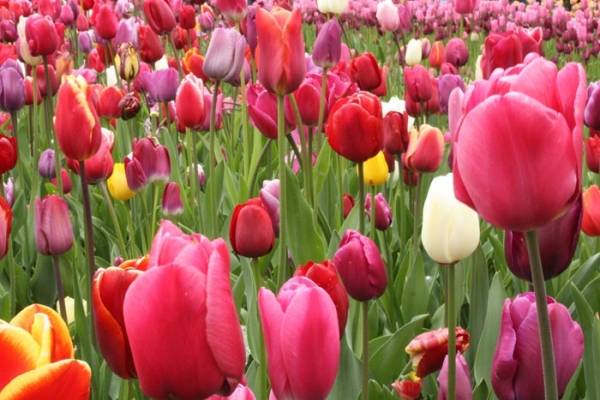

Tulips are popular with gardeners all over the world.
Tulip care, watering and flower feeding
- Caring for tulips should be started in early spring, when their red shoots just appeared from the ground. In this case, you will have to remove the bulbs of the non-germinated plant, destroying them, because this will make it possible not to get sick with other tulips.
- Watering such flowers should be carried out regularly and abundantly, especially if the weather outside is warm. After 3 weeks after the end of flowering, watering should be stopped, and the soil between the plants should be loosened and weeded.
- The tulip report shows that the first feeding of these flowers is done after germination. The soil needs to be fertilized a second time before the buds appear. The third feeding of tulips is necessary for them with the active formation of buds. The fourth dressing usually occurs at the beginning of the tulip flowering.
- Weeding and loosening of the soil in the area with these plants is carried out regularly.
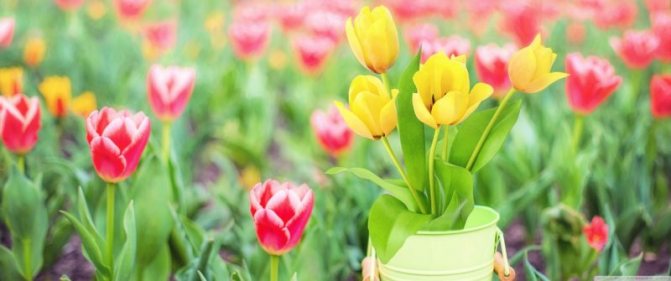

Early flowering group
Representatives of these varieties bloom in mid-late April.
- Simple early tulips. They are characterized by tall, thick stems. The buds are large. Their shape is similar to a bowl or glass, the color is mainly red or yellow. In the bright sun, they fully unfold. They grow slowly.
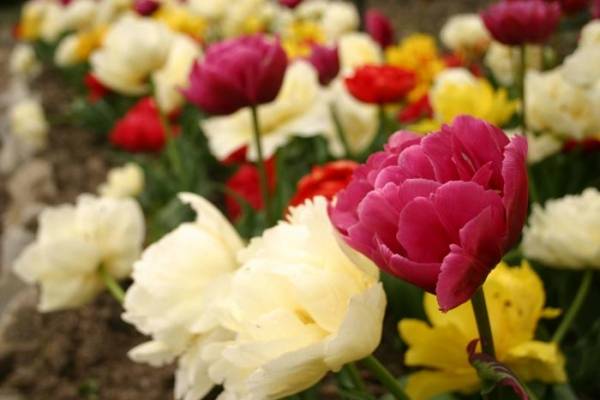

Terry early tulips
- Terry early. They have a short, strong and thick stem. Terry buds, warm tones, when opened, their diameter is about 8 cm. In terms of numbers, they make up almost the same percentage as the first class - about 5%. They grow very slowly.
Advice. In order for tulips to bloom well every year, at the end of the season, remove the bulbs from the ground and plant them in a new place in the fall.
The healing properties of tulips
- The chemical composition of tulips confirms that this plant contains such useful substances as tuliposides A, B and C, as well as the alkaloid tulipine. This is the reason for the antibacterial and antifungal properties of the tulip.
- In folk medicine, this flower is used in the treatment of certain cardiovascular diseases, because tulips have cardiotonic properties.
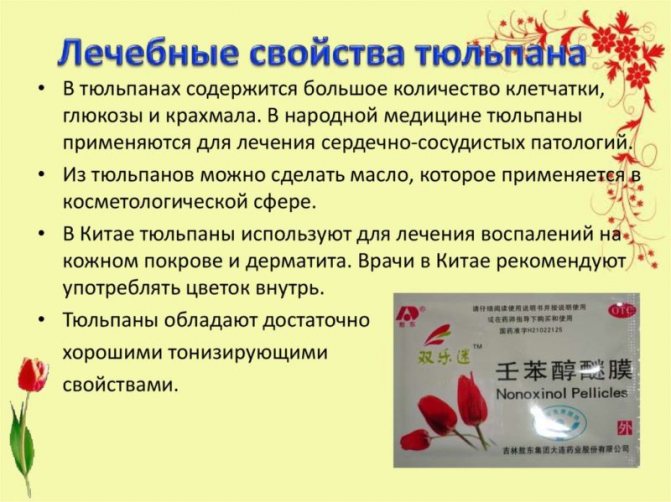

Tulip flowers benefits and treatments
- Chinese folk healers use tulip tinctures for diarrhea, indigestion, various types of poisoning, as well as for tumors.
- Tulip oil is used in the treatment of certain dermatological diseases. It is also used in the manufacture of nourishing face masks in the field of home cosmetology.
- The use of a tulip will be advisable for inflammation of the skin, for rheumatism, for arthritis and for arthrosis.
Read also: Nepentes Raja flower hunts insects and birds
Harm of tulip flowers and contraindications
- Before being treated with these plants, you need to know that only edible varieties of the tulip flower have medicinal properties. Gunther's tulip, for example, is highly toxic. The Gesmer tulip is also toxic. It is forbidden to consume them inside because of the danger of death and severe intoxication of the body.
- The tulip bulb contains some allergens. With constant contact of a person with this flower, especially in florists, the development of "tulip dermatitis" may be likely. Symptoms of this disease: tingling in the fingers, itching and peeling of the skin, eczema, nail damage.
- The use of tulips is categorically contraindicated during pregnancy, breastfeeding and among children.


Storing the bulbs
Dig up the bulbs for storage around the end of June or July. But before drying, it is recommended to treat them with a solution of manganese or karbofos to destroy pathogens. Then the heads are laid out on racks and dried in a dry, well-ventilated place. The attic is ideal for this.
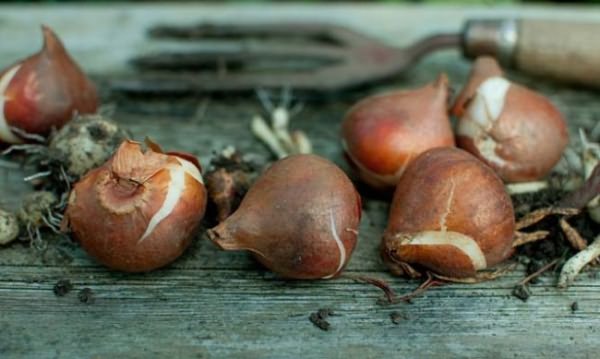

After that, the bulbs are cleaned of dirt and old husks, the nests are divided and sorted, removing the damaged and diseased ones. Planting material is placed on racks or in ventilated boxes and stored until autumn at a temperature of 22-23 ° C, gradually lowering the temperature to 15-17 ° C. During the entire storage period, you need to inspect the bulbs and remove those that have an unhealthy appearance.
Flower auction
Tourists will be interested in visiting flower auctions. It's both fun and educational. After all, auctions are held not only to sell as many tulips as possible, but also to entertain the public.
Trading begins at sunrise. The auction is open all year round, but the best time to visit the Land of Tulips is spring and summer. It is during these seasons that the entire territory of Holland is covered with multi-colored rectangles, on which tulips, daffodils, hyacinths, and lilies bloom alternately. Kilometers of neat plantings go into the distance, delighting guests of the country and local residents.
Holland or Netherlands?
Many people confuse these two names, but you cannot put an equal sign between them. The Netherlands is a country that consists of 12 provinces. Two of them together form Holland - the Land of Tulips. This is North and South Holland. But the name "Holland" is used to refer to the entire territory of the Netherlands.
The official name of the country is the Kingdom of the Netherlands. This area is called the country of tulips due to the fact that a huge part of its territory is covered with multi-colored tulip fields, which look like the flags of different countries replacing each other.
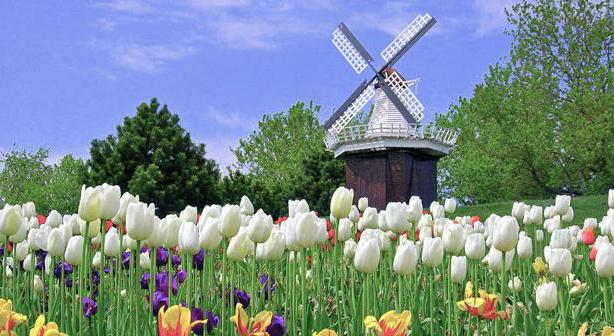

When to plant?
In autumn
Disembarkation rules:
- Despite the fact that ordinary flowers are recommended to be planted in the spring, the situation is different with tulips. The optimal period is September.
- It is best to prepare the soil 2-3 weeks before planting the bulbs.The work is to treat the soil properly, fertilize it with humus, compost or fertilizers based on superphosphate, nitrogen and potassium salt. However, it should be remembered that nothing has been invented better than natural ingredients.
- After digging, the place for the seedlings is covered with foil.
- Weed plants should be removed periodically during the preparation process.
- During the landing period - September, you can start the process. To do this, you need to make special holes with a shallow depth and fill them with real rainwater.
- It should be noted that the hole should go deep 3 bulbs down, and when the seedling is covered with earth, the middle is left.
- In late October or early November, the landing site is covered with mown grass to avoid freezing.
In the spring
Planting tulips in a groove
Recommendations:
- It is best to plant the bulbs in the fall.
- If, nevertheless, this did not work out, then you need to understand that such plants will open later.
- Before planting, keep the bulbs in the refrigerator at night, but not in the freezer.
- In the morning, you need to rinse the bulbs in a solution of potassium permanganate and then rinse.
- Disembarkation takes place in April or earlier. If the region is quite cool, then this can be done in a container, and then, with the onset of warm days, the seedlings can be planted in the ground.
- Prepare the soil before planting. To do this, we remove the weeds, dig up and loosen it by 5 cm.
- We make holes or grooves.
- You can plant tulips and sprinkle with earth.
Floriada
But Keukenhof is only open for 9 weeks. Although it is the largest park, there is a project in the Land of Tulips that surpasses the Keukenhof in scale. This is the world famous horticultural exhibition that takes place in Holland only once a decade - "Floriada".
Various cities in the Netherlands are constantly fighting for the right to host this famous exhibition. The city of Almere is a candidate for the next Floriada, which will take place in 2022. The exhibition area is about 66 hectares. Usually, there are not only picturesque flower beds, but also various pavilions, cinemas, recreation areas and attractions.
Cooking use
In the culinary arts of many countries, tulip flowers are a real delicacy. The flower trend in the world of culinary originates from England. In the country of foggy Albion, since the 16th century, cookbooks have hidden recipes for flower syrups, salads, tinctures and even candied petals. Sweet petals are the most popular in France today.
Exotic tulip dishes can be enjoyed in Dutch restaurants. Tulips are appreciated not only as a dessert, but also as a wonderful hot dish, which is obtained by frying their petals in batter. Tulips go well with fish and meat dishes.
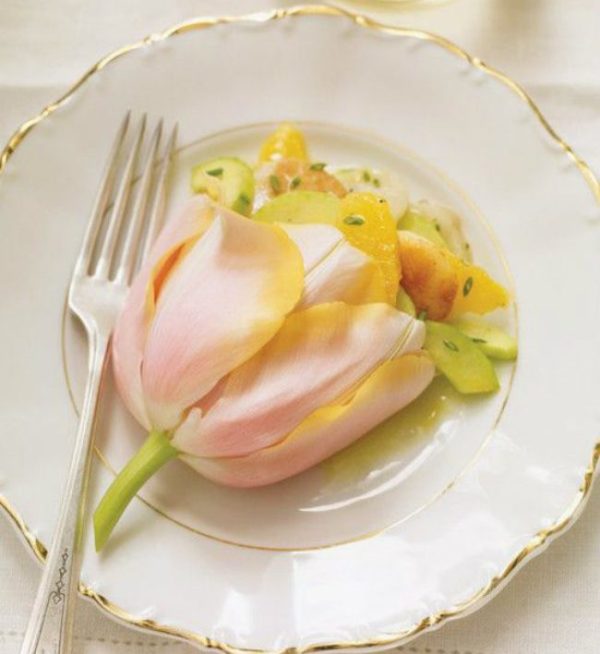

One of the restaurants in Vancouver has prepared a real "tulip menu". In spring in this restaurant you can taste asparagus and feta cheese with fried tulips or salad from the shoots of this plant of the "Emperor" variety. The restaurant also prepares charcoal fish with a warm salad with tulip flowers and sauce. The buds of these flowers taste like Brussels sprouts under the sauce. For dessert, the restaurant offers a deliciously delicious cake with flower petals. The combination of tulips, whipped cream and lemon will leave no one indifferent.
At home, you can cook an amazingly delicious dish called "tulip petals in batter". For this dish you will need 3 large red flowers, 150 grams of flour, half a glass of white wine and the same amount of olive oil, a chicken egg, 5 grams of yeast. The flour is diluted with wine, then yeast and yolk are added to the mixture, a little water is poured in. The mixture is thoroughly mixed and left to ferment for half an hour.The whipped protein is added to the resulting dough, the petals are dipped first in the dough, and then fried in boiling oil until golden brown. After frying, the petals should be dried on a napkin. The dish is served hot.
Tulip bulbs are also edible, they are baked in a fire, they taste like potatoes, only they have a sweet aftertaste.
The green leaves of the plant are great for making vitamin salad. Young leaves are cut into strips and mixed with chopped green onions, 1 tablespoon of vinegar is added to the salad. The salad is left for one hour in order to get rid of excessive bitterness, then the vinegar is decanted and the salad is seasoned with olive oil.


